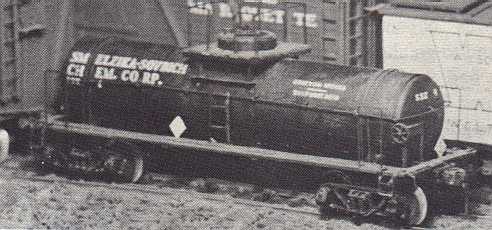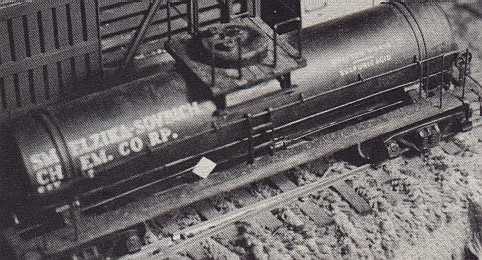Support this website by joining the Silver Rails TrainWeb Club for as little as $1 per month.
Click here for info.
This website has been archived from TrainWeb.org/s-trains to TrainWeb.US/s-trains.
Return to previous page by DEL AMERINE Advance to Index page
| The Athearn body I used for my first car was almost completely
assembled, so I left the running board at bolster height and used the handrail
where it was. However, since it might be expected that such homegrown cars
would differ widely one from another, I discarded the running board on
my second car and built one from stripwood about mid-height of the tank.
If the existing running board is to be retained, it must be widened by the addition of one 1/32 x '/8" plank along the outside. This is supported by short wood extensions of the underframe members (the underframe being zamac, T wouldn't venture to try solder on it), and by the old corner steps, which are bent straight out. New steps may be made of brass strip, pinned and glued to the wood running boards. |

Photo: Smelzika-Sovbieh Chemical Corp. tank ear #4 stands in Canfield Yard while enroute to firm's fertilizer works at Grafton on the Canfield & Northern Railroad. Car is freelance, converted from an HO kit, but very similar to real 3,000-gallon tank cars. Couplers are Roundhouse HO knuckle couplers, side-operated by lever. Rail is code 70. |
| I retained the HO brake system on my first car, a flagrant violation
of ethics but it saved time (and model railroading Is for FUN) and since
the car is all black, what the hell?
When it came to brake wheels the boys at SmelzikaSovbich really had a ball. Each car is a little different; my first has a side-operated wheel on a short staff mounted horizontally in a box and linked by a chain to a bell crank below, which pivots on a fixed rod and in turn would--if the system operated--pull the brake cylinder piston. The Athearn dome is, of course, substantially undersize for an S Gauge conventional dome. But it's not bad here, inasmuch as chemical domes are commonly small. So I just built up a platform of stripwood around the dome to further emphasize the dome's smallness. |

Photo: Overhead close-up shows wood plank platform and railing. Note brake wheel at end of car, attached by chain to bell crank below, which is attached to rod from brake cylinder. Note addition of stripwood plank along outside edge of walkway, with original HO steps at corners bent out as handholds. New steps are bent from strip brass. |
| I used 1/16" wood angles for the frame members, firmly wedging
the four "feet" of the platform behind the existing Athearn top step on
either side of the tank so that glue was almost unnecessary. The
platform is topped off with a wire handrail soldered to wire supports,
which are inserted in the platform.
I painted the car flat black. A little rust is coming through very appropriately. Some verticle streaks of gloss black would not be a bad idea, since vertical strokes would appear to be flow streaks. But make all strokes vertical; horizontal streaks would be hard to explain. |
I lettered my car with a brush and ordinary white house paint.
In such minute quantities even a slowdrying paint dries fast and model
railroad paint would be dry on the brush tip before you could get it out
of the bottle. Enhorning makes several chemical car decals but none
for the yellow and green duPont cars [ see around here. Who knows--if
you wrote to duPont they might be able to scrounge something for you themselves.
Spot that covered hopper full of phosphate rock right here, gents, we're in the fertilizer-making business. |
Support this website by joining the Silver Rails TrainWeb Club for as little as $1 per month.
Click here for info.














